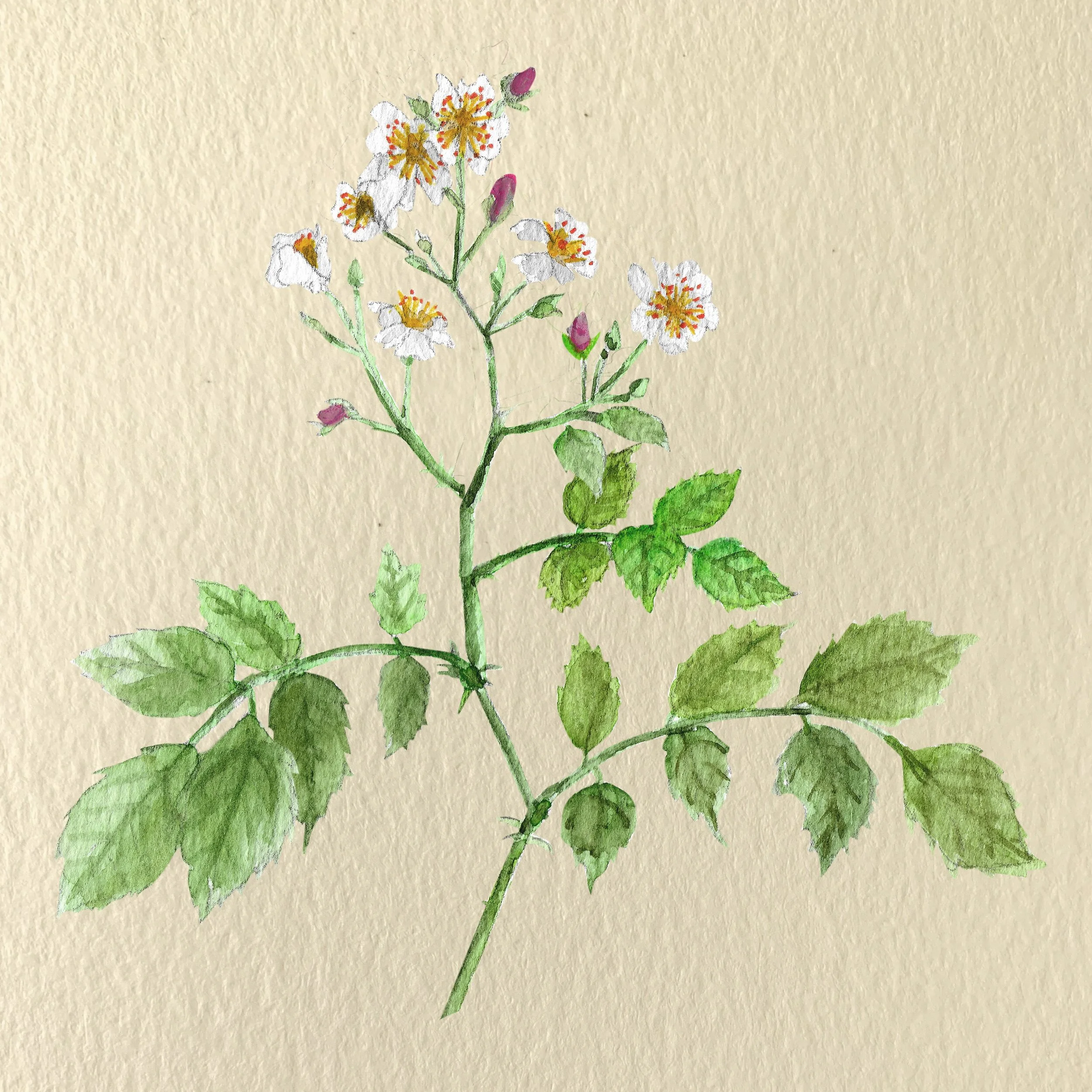Rosa multiflora. Illustration by Michelle Enemark.
MULTIFLORA ROSE
HONEY ROSE ELIXIR RECIPE
Fill a jar about 3/4s full with blossoms (it's okay to include a bit of the green stem and some buds). In a separate jar mix equal parts honey and bourbon or brandy, then pour this over the flowers. Stir, and perhaps sample, every day. Unlike some elixirs that take a few weeks to brew, this will start tasting wonderful in just a few days, but as always, the longer you brew the more potent becomes the medicine.
For a ROSE HONEY, just omit the bourbon. This is one of the most delicious treats in the world and makes a lovely gift! And then, if you don't devour this overnight and the honey hardens, you can add bourbon later to turn it into an elixir...
MEDICINAL USES
Multiflora rose has been used medicinally since ancient times and can be made into many remedies. But for me, this rose, like so many other roses, is a medicine of love. She marks the beginning of truly warm days and longer nights when her sweet fragrance brings romance to the air... I find her to be a bit more subtle, and much more magical in making women's hormonal tonics and aphrodisiac medicine - for support in conception, libido, and bringing on late menstruation. For this one could take the elixir, eat the honey, or make a tea from the blossoms, buds, and leaves (fresh or dried).
Every year I think I will put up quarts and quarts of multiflora elixir, but then, she opens her blossoms one night, intoxicates with her beauty and fragrance the next day, it rains, and then, the blossom is brown and almost gone... how quickly it all happens. Unlike honeysuckle or yarrow, which were in blossom at the same time this year and have quite robust flowers, multiflora rose fades quickly. You know which blossoms to harvest for good medicine because they are the same ones the bees are busy pollinating. She is so extremely prolific in most areas where she grows, that we don't worry too much about over harvesting, but as always, do leave plenty for the sweet bees. When she first begins to open, I pluck those blossoms straight from the bush and leave the rest of the buds. Later when all the buds have opened, I snip off whole stems of blossoms for faster processing with scissors.
Like the bees, I have always been attracted to the flowers of multiflora rose, but I have been getting the feeling that the leaves have potent medicine as well. Indeed, research shows that the leaves contain Vitamin C - like the rose hips (the red fruit which comes on around September). Vitamin C is heat sensitive, so I am thinking that you would not want to make a tea with boiling water, but rather a cold infusion would be interesting (pour cold water over the leaves and allow to steep overnight). Since the dear flowers are ALREADY GONE - AGAIN! - sigh - I will be experimenting with the leaves over the summer and will report back. You would want to use the younger leaves that seem to always be popping out at different times of year due to new plant growth or pruning.
I have read that multiflora rose is a relaxing nervine, though I haven't used her in this way myself. (Some of my favorite nervines are skullcap and catmint, which are very potent and will knock you to sleep pretty quick if you're not careful.)
Multiflora rose is astringent, anti-inflammatory, and soothing, which makes her a unique healer for both skin and respiratory issues. (Think of a plant like yarrow which is also astringent, but not really soothing at all.) The petals may be used as cough medicine or added to another cough remedy.
The seeds are a good source of vitamin E and are ground up as a nutritional supplement in many foods (another great golden years or end times project??).
HISTORY
Multiflora rose originally came to us in North America from its native Japan (also native to China and Korea). It was used for its rootstock, wildlife forage and as a natural fence row. Well, it spread like the wild beautiful thing that it is and now she is a most wanted invasive weed in many locations. It fills the fallow fields and fence rows where farmers still allow it in my native rural Missouri. But much of the multiflora rose has been cleared along with everything else - corporate agriculture has pushed farmers to cultivate every single inch of soil and so much of the old fence row and bramble has been removed. This has also removed the home habitat of the bobwhite quail and pheasant, which are now a rare sight in many rural locations.
This sweet plant is featured in Chapter 12: In the Garden.
*Disclaimer*
This material is intended for educational purposes only. This recipe does not provide specific dosage information, format recommendations, toxicity levels, or possible interactions with prescription drugs. Accordingly, this information should be used only under the direct supervision of a qualified health practitioner.

